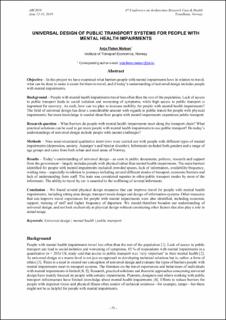| dc.description.abstract | Objective – In this project we have examined what barriers people with mental impairments have in relation to travel, what can be done to make it easier for them to travel, and if today’s understanding of universal design includes people with mental impairments.
Background – People with mental health impairments travel less often than the rest of the population. Lack of access to public transport leads to social isolation and worsening of symptoms, while high access to public transport is important for recovery. As such, how can we plan to increase mobility for people with mental health impairments? The field of universal design has done a considerable amount with regards to public transit for people with physical impairments, but more knowledge is needed about how people with mental impairments experience public transport.
Research question – What barriers do people with mental health impairments meet along the transport chain? What practical solutions can be us ed to get more people with mental health impairments to use public transport? Do today’s understandings of universal design include people with mental challenges?
Methods – Nine semi-structured qualitative interviews were carried out with people with different types of mental impairments (depression, anxiety, Asperger’s and bipolar disorder). Informants included both genders and a range of age groups and came from both urban and rural areas of Norway.
Results – Today’s understanding of universal design—as seen in public documents, policies, research and support from the government—largely includes people with physical rather than mental health impairments. The main barriers
identified for people with mental impairments included crowded spaces, lack of information, availability/frequency, waiting time—especially in relation to journeys including several different modes of transport, economic barriers and lack of understanding from staff. The train was considered superior to other public transport modes by most of the informants. The ability to travel by car is essential to the wellbeing of several informants.
Conclusion – We found several physical design measures that can improve travel for people with mental health impairments, including sitting area design, transport mode design and design of information systems. Other measures that can improve travel experiences for people with mental impairments were also identified, including economic support, training of staff and higher frequency of departure. We should therefore broaden our understanding of universal design, and not look exclusively at physical design without considering other factors that also play a role in actual usage. | |

